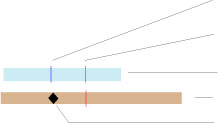|
|
|
Herbicide
(Trade or common name)
|
Rate of detec-
tionb
|
Concentration,
in mg/L

|
|
|
Acetochlor
|
7%
0%
|

|
|
Acifluorfen (Blazer, Tackle 2S)
|
1%
0%
|

|
|
Alachlor (Lasso)
|
15%
0%
|

|
|
2,6-Diethylaniline (Alachlor metabolite)
|
<1%
0%
|

|
|
Atrazine (AAtrex, Gesaprim)
|
88%
3%
|

|
|
Deethylatrazinec (Atrazine metabolite)
|
71%
4%
|

|
|
Bentazon (Basagran, bentazone)
|
4%
1%
|

|
|
Bromacil (Hyvar X, Urox B, Bromax)
|
<1%
1%
|

|
|
Bromoxynil (Buctril, Brominal, Torch)
|
<1%
0%
|

|
|
Butylate (Sutan, Genate Plus, butilate)
|
<1%
0%
|

|
|
Chloramben (Amiben, Vegiben)
|
<1%
0%
|

|
|
Clopyralid (Stinger, Lontrel, Dowco 290)
|
1%
0%
|

|
|
Cyanazine (Bladex, Fortrol)
|
5%
0%
|

|
|
2,4-D (2,4-PA)
|
17%
2%
|

|
|
DCPA (Dacthal, chlorthal-dimethyl)
|
<1%
<1%
|

|
|
Dacthal, mono-acid (Dacthal metabolite)
|
<1%
0%
|

|
|
Dicamba (Banvel, Mediben, dianat)
|
1%
0%
|

|
|
Dichlorprop (2,4-DP, Seritox 50, Kildip)
|
3%
0%
|

|
|
Dinoseb (DNBP, DN 289, Premerge, Aretit)
|
1%
0%
|

|
|
Diuron (Karmex, Direx, DCMU)
|
7%
0%
|

|
|
EPTC (Eptam)
|
1%
0%
|

|
|
Fluometuron (Flo-Met, Cotoran)
|
17%
0%
|

|
|
Linuron (Lorox, Linex, Sarclex)
|
1%
0%
|

|
|
MCPA (Agritox, Agroxone)
|
3%
0%
|

|
|
MCPB (Can-Trol, Thistrol, Tropotox)
|
<1%
0%
|

|
|
Metolachlor (Dual, Pennant)
|
69%
0%
|

|
|
Metribuzin (Lexone, Sencor)
|
10%
2%
|

|
|
Molinate (Ordram)
|
18%
0%
|

|
|
Napropamide (Devrinol)
|
<1%
0%
|

|
|
Neburon (Neburex, Noruben, Kloben)
|
<1%
0%
|

|
|
Oryzalin (Surflan, Dirimal, Ryzelan)
|
3%
0%
|

|
|
Pendimethalin (Prowl, Stomp)
|
10%
0%
|

|
|
Picloram (Tordon, Amdon)
|
1%
0%
|

|
|
Prometon (Gesagram, prometone)
|
50%
4%
|

|
|
Pronamide (Kerb, propyzamid)
|
2%
0%
|

|
|
Propachlor (Ramrod, propachlore)
|
1%
0%
|

|
|
Propanil (Stampede, Surcopur)
|
5%
0%
|

|
|
Propham (Chem-Hoe, IPC, prophame)
|
1%
0%
|

|
|
Simazine (Aquazine, Princep, Gesatop)
|
63%
<1%
|

|
|
Tebuthiuron (Spike, Perflan)
|
42%
2%
|

|
|
Thiobencarb (Bolero, Saturn, benthiocarb)
|
8%
0%
|

|
|
Triclopyr (Garlon, Grazon, Crossbow)
|
1%
0%
|

|
|
Trifluralin (Treflan, Trinin, Elancolan)
|
3%
0%
|

|












































